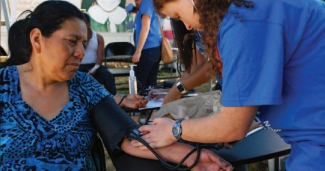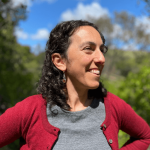Summer Streamline: Integrated Team-Based Approach to Hypertension at Virginia Garcia
photo courtesy of Viriginia Garcia Memorial Health Center
By Claire Hutkins Seda, Writer, Migrant Clinicians Network, and Managing Editor, Streamline
[Editor’s Note: It’s summer! That means the summer issue of Streamline has arrived in mailboxes around the country. This issue features articles on culturally competent medical history-taking, disasters and mental health response teams, a Health Network case study, obesity among agricultural worker children, and conversations with patients about the cost of care. Read the complete issue, and all our back issues, here. If you’d like to subscribe to receive Streamline in-print and at no cost to you, please email your address to: contedu@migrantclinician.org ]
Four years ago, the providers at Virginia Garcia Memorial Health Center, a Community Health Center in Oregon, took a hard look at how they managed patients with hypertension. Nationwide, this chronic disease is affecting one in three adults, and increasing those patients’ risk for cardiovascular disease, the number one killer in the US. Since then, Virginia Garcia has increased the number of patients with controlled hypertension by a small but notable three percent. Eva Galvez, MD, physician at Virginia Garcia and a member of Migrant Clinicians Network’s Board of Directors, credits the increase in blood pressure control to Virginia Garcia’s hypertension registry, the increased frequency of patient visits for those with hypertension, a team-based treatment plan, strong links to providers to address social determinants of health and mental health concerns, and a “big picture” approach to provider-patient communication around hypertension.
Oregon’s Alternative Payment Methodology At Work At Virginia Garcia, the frequent nurse visits at the heart of this strategy might not have been possible just a few years ago. That’s because Virginia Garcia, like several other Oregon community health centers, has worked with Oregon’s Medicaid program to buck the fee-for-service norm. In the past, Virginia Garcia only received payment when a patient had a “billable encounter” with a limited set of providers such as a doctor. Now, they receive a per-patient, per-month payment, which makes it possible for their diverse care teams to work with each patient to support their health in the most effective way. This approach, called the Alternative Payment and Advanced Care Model, is part of Oregon’s coordinated care approach to improve the quality of health care and limit the growth in health care spending.Care teams, which may include community health workers, behaviorists or nutritionists, can now spend the time to develop a fuller understanding of the patient’s medical and life circumstances to jointly determine the appropriate needs and care plan, allowing teams to treat the whole person, paying attention to their health as well as its economic, environmental, and social causes. “The flexibility in the payment allows Virginia Garcia to creatively determine how to improve care for everyone on the panel, Dr. Galvez shared. “This payment structure allows for frequent nurse visits and the funding of care team members like the CHW, nutritionist, and behavioral health practitioner,” Dr. Galvez added.
“Hypertension can be so difficult to control,” Dr. Galvez admitted. “Our patients are working. They’re busy. It takes everything they have to get to their [provider] visits,” but Virginia Garcia has stepped up to the challenge to meet patients where they are, make health care work for them, and make a lasting impact on patients’ health.
The first change was to better identify patients with hypertension. Often, hypertension is newly identified when patients are attending an appointment for another health concern. To make sure sufficient time and focus are given to the new diagnosis, they are placed on a registry that sets into motion the layered approach that Virginia Garcia has developed.
“From diagnosis, we are actively reaching out to them to try to get them in,” for a follow-up appointment with a registered nurse, just two weeks after diagnosis, Dr. Galvez noted. The nurse assesses how the patient is adapting to the treatment plan, and, under Dr. Galvez’s supervision, can adjust medications if needed. It’s also a chance for the nurse to dive deeper into lifestyle changes and possible barriers to change. The frequency of visits remains high until the patient gets on track and doesn’t require medication adjustments.
“Can they afford medications? What are their goals? We identify barriers to achieve those goals -- and then give a warm handoff to those who can help address them,” Dr. Galvez said. If a patient is smoking, for example, a nurse might uncover that the patient smokes because she is suffering from high levels of stress. She may then be introduced to the Community Health Worker (CHW), who has a stronger focus on social determinants.
“It’s hard to focus on eating healthy if you’re stressed, depressed, or worried about your family being deported. Through our team-based approach, we can address some of the stressors they have. That can remove some of the huge barriers,” Dr. Galvez emphasized.
“I had a patient who was trying to [get his hypertension under control] but was also dealing with moving -- and was worried that he was going to end up homeless. Our CHWs were identifying the barriers and providing resources, and our nurse was reporting back to me as the provider. In a different clinic, you wouldn’t know for three months down the road [until the next visit] what was going on with that patient,” but in this situation, Dr. Galvez explained, the health center intervened early to help the patient manage a stressful situation and get back on the track to health. The team also includes a clinical pharmacist, who may also make prescription adjustments under the supervision of Dr. Galvez. “The clinical pharmacist or a registered nurse can get 20 or 30 minutes to sit down and talk with the patient,” when Dr. Galvez’s time is too limited to provide that much time. Additionally, Dr. Galvez’s clinic has on staff a nutritionist providing popular classes in Spanish and English, as well as behavioral health providers. Each is ready for a warm handoff. Group visits are another key aspect to care. “The patients learn from each other,” and feel less isolated in their struggles, she said.
The cost of care and time away from work are issues for patients, including Virginia Garcia’s patients. To better meet patients’ needs and address these concerns, Virginia Garcia has reimagined their services. Patients who aren’t able to come in with such frequency can complete a visit over the phone, with nurses guiding the patients through how to take their blood pressure from home.
Dr. Galvez emphasizes that a critical part of a successful approach must encompass the way clinicians communicate to patients about hypertension. In most health centers, the provider explains that hypertension is a serious chronic condition and requires medication, and that the patient should focus on exercise and diet changes to get the condition under control -- and the conversation ends there. “Most of our patients want to be healthy and live a long time. If we, as clinicians, make time to sit down with the patient and explain what the ultimate goal is -- to decrease death from cardiovascular disease -- I think most people get engaged,” she said. “We get so caught up in talking about blood pressure numbers and medications, we forget what the big picture is. Why does my blood pressure have to be 140/80? When I tell a patient, ‘long term, high blood pressure is damaging your kidneys and your heart and your brain, and you’re at risk of dying from a heart attack or stroke,’ most people pay attention. This is where we have to do the work -- not just with moving the numbers. Most people want to be around for their grandkids.” With Virginia Garcia’s hypertension interventions, more patients will be able to do just that.
1 “High Blood Pressure.” Centers for Disease Control and Prevention. https://www.cdc.gov/bloodpressure/index.htm. Accessed June 5, 2018.
In April, Dr. Galvez joined MCN for the first session of our Hypertension ECHO series, which brought top experts and the latest data on hypertension directly to frontline workers at health centers around the country. Here is a selection of resources provided to our Hypertension ECHO participants during that introductory session.
The Seventh Report of the Joint National Committee on Prevention, Detection, Evaluation, and Treatment of High Blood Pressure, from the National Institutes of Health’s National Heart, Lung, and Blood Institute, is available in English at https://goo.gl/yAt8hH and in Spanish at https://goo.gl/cxnk71.
National Heart, Lung, and Blood Institute’s High Blood Pressure page reviews all the basics for patients in English at https://goo.gl/vaPSTg and in Spanish at https://goo.gl/sbH2k1.
“Do You Have High Blood Pressure?” is a low-literacy one-page resource from the CDC for patients, available in English at https://goo.gl/1K5LHV and in Spanish at https://goo.gl/jj3YQ2.
Read more about Alternative Payment Methodology in the Winter 2016 issue of Streamline: https://goo.gl/pokLEp.
Learn more about Virginia Garcia’s programs: http://virginiagarcia.org.
Update 7/11/18: An earlier version of this article incorrectly identified Virginia Garcia as a Coordinated Care Organization. It is a Community Health Center. The error has been corrected.
The material presented in this portion of Streamline is supported by the Health Resources and Services Administration (HRSA) of the U.S. Department of Health and Human Services (HHS) under cooperative agreement number U30CS09742, Technical Assistance to Community and Migrant Health Centers and Homeless for $1,094,709.00 with 0% of the total NCA project financed with non-federal sources. This information or content and conclusions are those of the author and should not be construed as the official position or policy of, nor should any endorsements be inferred by HRSA, HHS or the U.S. Government.
Read this article in the Summer 2018 issue of Streamline here!
Sign up for our eNewsletter to receive bimonthly news from MCN, including announcements of the next Streamline.
- Log in to post comments

